Business Strategy and CAGE Framework: Amazon and Apple Analysis
VerifiedAdded on 2020/03/04
|5
|1435
|264
Report
AI Summary
This report provides a comprehensive analysis of the competitive strategies employed by two industry giants: Amazon and Apple. The analysis delves into Amazon's concentric diversification strategy, cost leadership, and its expansion through the CAGE framework, highlighting its innovative approach to online retail and global market penetration. The report then examines Apple's vertical integration strategy, emphasizing its control over hardware, software, and services, and its business model innovations, such as the iTunes Store and App Store. The CAGE framework is also applied to Apple, focusing on its product differentiation and global expansion. The report uses references to support the analysis of both companies' strategic approaches and their impact on the market.
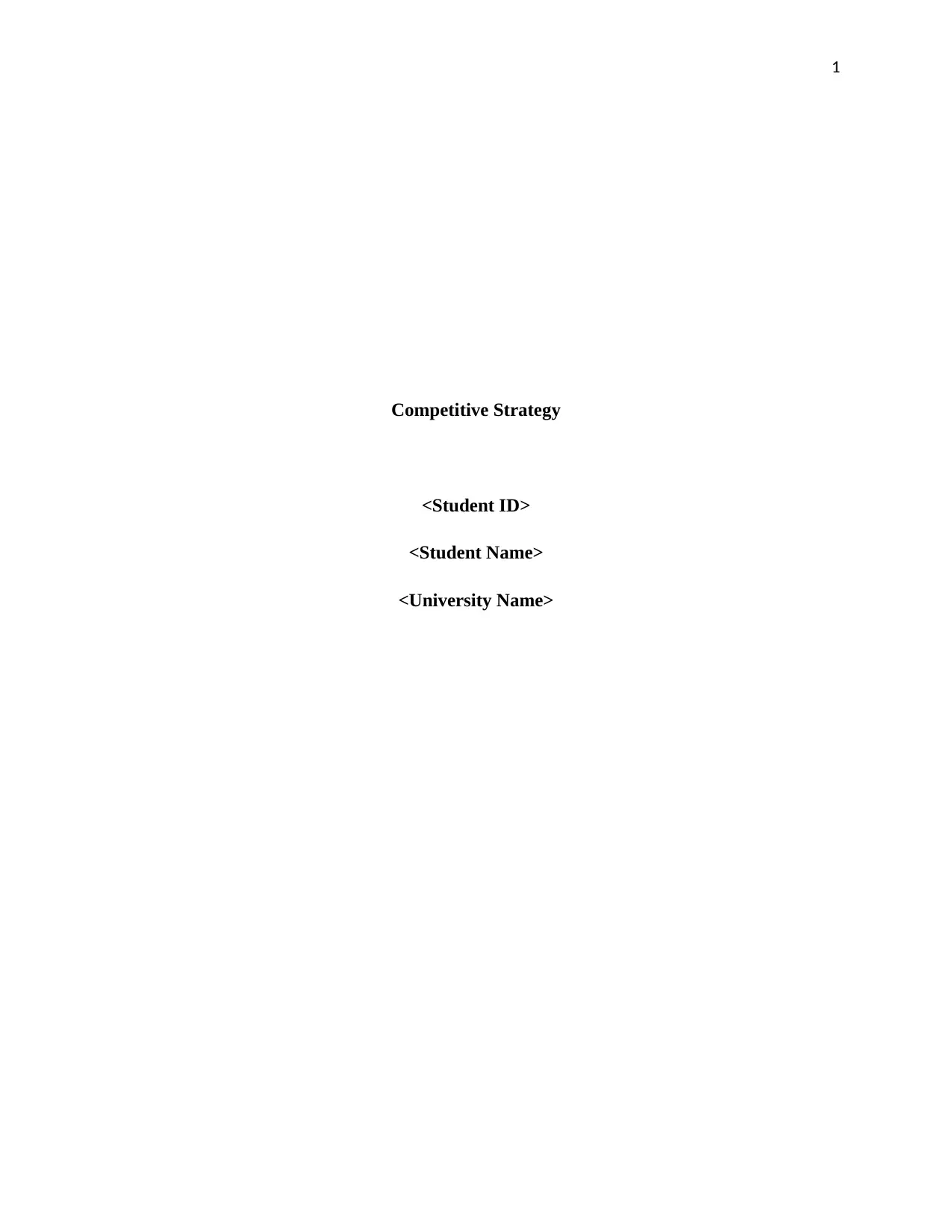
1
Competitive Strategy
<Student ID>
<Student Name>
<University Name>
Competitive Strategy
<Student ID>
<Student Name>
<University Name>
Paraphrase This Document
Need a fresh take? Get an instant paraphrase of this document with our AI Paraphraser
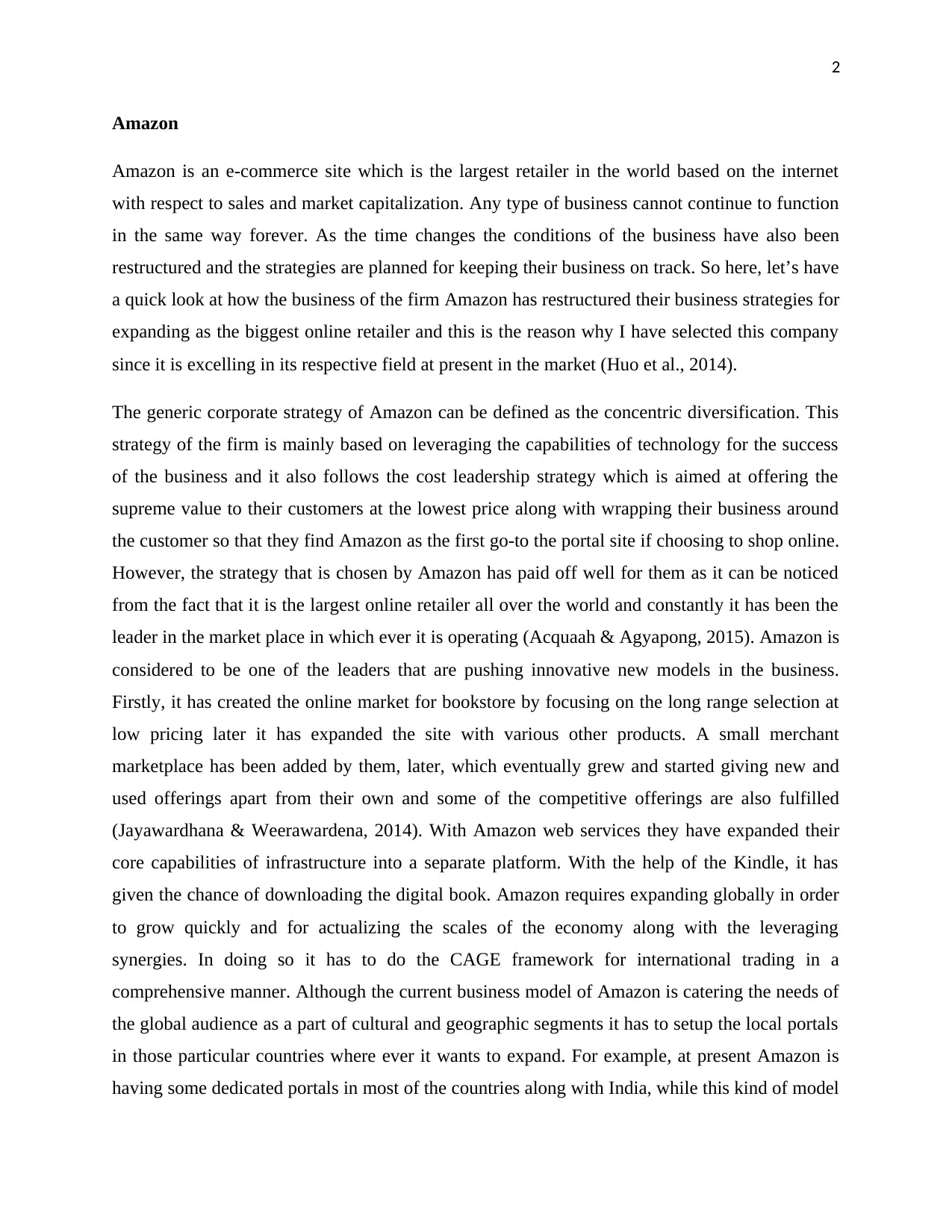
2
Amazon
Amazon is an e-commerce site which is the largest retailer in the world based on the internet
with respect to sales and market capitalization. Any type of business cannot continue to function
in the same way forever. As the time changes the conditions of the business have also been
restructured and the strategies are planned for keeping their business on track. So here, let’s have
a quick look at how the business of the firm Amazon has restructured their business strategies for
expanding as the biggest online retailer and this is the reason why I have selected this company
since it is excelling in its respective field at present in the market (Huo et al., 2014).
The generic corporate strategy of Amazon can be defined as the concentric diversification. This
strategy of the firm is mainly based on leveraging the capabilities of technology for the success
of the business and it also follows the cost leadership strategy which is aimed at offering the
supreme value to their customers at the lowest price along with wrapping their business around
the customer so that they find Amazon as the first go-to the portal site if choosing to shop online.
However, the strategy that is chosen by Amazon has paid off well for them as it can be noticed
from the fact that it is the largest online retailer all over the world and constantly it has been the
leader in the market place in which ever it is operating (Acquaah & Agyapong, 2015). Amazon is
considered to be one of the leaders that are pushing innovative new models in the business.
Firstly, it has created the online market for bookstore by focusing on the long range selection at
low pricing later it has expanded the site with various other products. A small merchant
marketplace has been added by them, later, which eventually grew and started giving new and
used offerings apart from their own and some of the competitive offerings are also fulfilled
(Jayawardhana & Weerawardena, 2014). With Amazon web services they have expanded their
core capabilities of infrastructure into a separate platform. With the help of the Kindle, it has
given the chance of downloading the digital book. Amazon requires expanding globally in order
to grow quickly and for actualizing the scales of the economy along with the leveraging
synergies. In doing so it has to do the CAGE framework for international trading in a
comprehensive manner. Although the current business model of Amazon is catering the needs of
the global audience as a part of cultural and geographic segments it has to setup the local portals
in those particular countries where ever it wants to expand. For example, at present Amazon is
having some dedicated portals in most of the countries along with India, while this kind of model
Amazon
Amazon is an e-commerce site which is the largest retailer in the world based on the internet
with respect to sales and market capitalization. Any type of business cannot continue to function
in the same way forever. As the time changes the conditions of the business have also been
restructured and the strategies are planned for keeping their business on track. So here, let’s have
a quick look at how the business of the firm Amazon has restructured their business strategies for
expanding as the biggest online retailer and this is the reason why I have selected this company
since it is excelling in its respective field at present in the market (Huo et al., 2014).
The generic corporate strategy of Amazon can be defined as the concentric diversification. This
strategy of the firm is mainly based on leveraging the capabilities of technology for the success
of the business and it also follows the cost leadership strategy which is aimed at offering the
supreme value to their customers at the lowest price along with wrapping their business around
the customer so that they find Amazon as the first go-to the portal site if choosing to shop online.
However, the strategy that is chosen by Amazon has paid off well for them as it can be noticed
from the fact that it is the largest online retailer all over the world and constantly it has been the
leader in the market place in which ever it is operating (Acquaah & Agyapong, 2015). Amazon is
considered to be one of the leaders that are pushing innovative new models in the business.
Firstly, it has created the online market for bookstore by focusing on the long range selection at
low pricing later it has expanded the site with various other products. A small merchant
marketplace has been added by them, later, which eventually grew and started giving new and
used offerings apart from their own and some of the competitive offerings are also fulfilled
(Jayawardhana & Weerawardena, 2014). With Amazon web services they have expanded their
core capabilities of infrastructure into a separate platform. With the help of the Kindle, it has
given the chance of downloading the digital book. Amazon requires expanding globally in order
to grow quickly and for actualizing the scales of the economy along with the leveraging
synergies. In doing so it has to do the CAGE framework for international trading in a
comprehensive manner. Although the current business model of Amazon is catering the needs of
the global audience as a part of cultural and geographic segments it has to setup the local portals
in those particular countries where ever it wants to expand. For example, at present Amazon is
having some dedicated portals in most of the countries along with India, while this kind of model
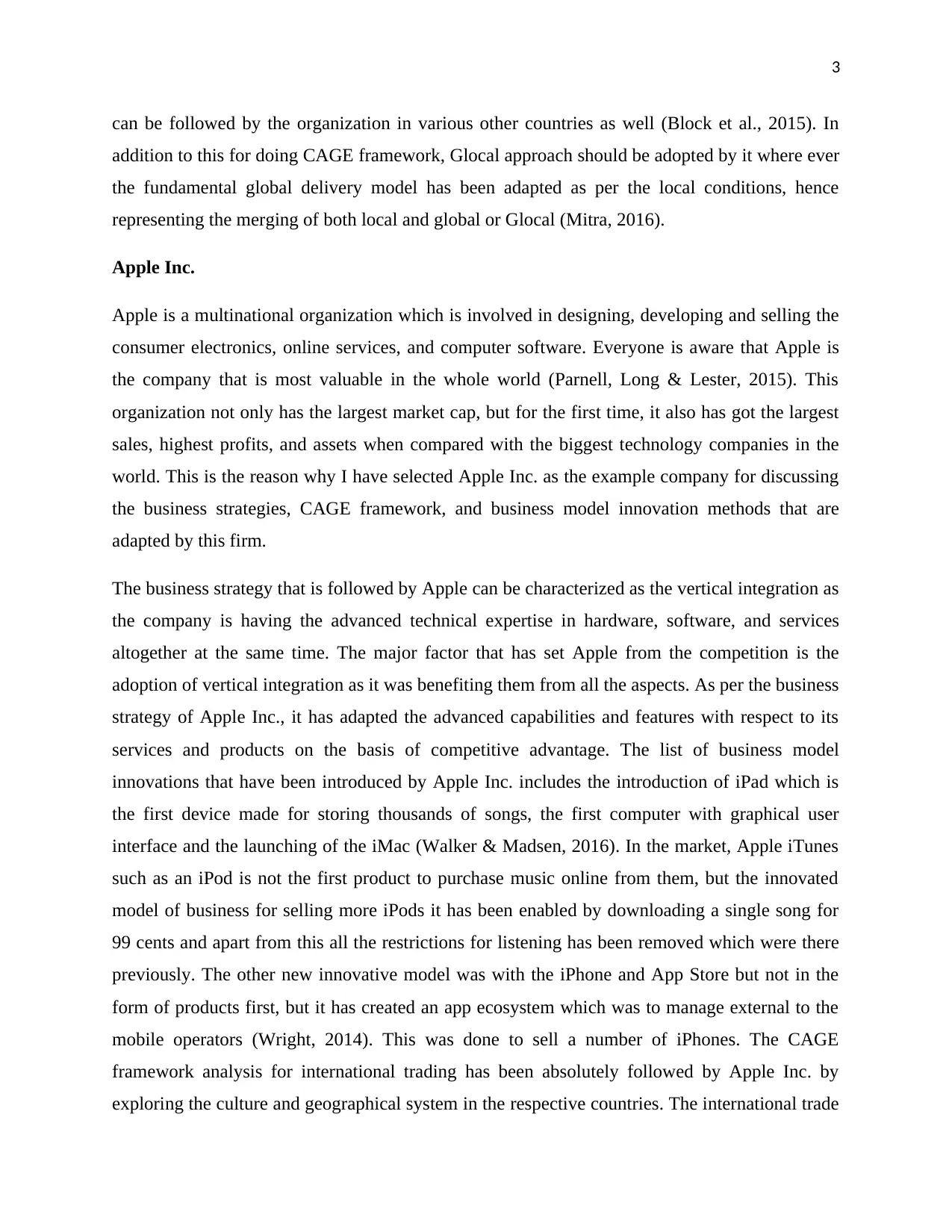
3
can be followed by the organization in various other countries as well (Block et al., 2015). In
addition to this for doing CAGE framework, Glocal approach should be adopted by it where ever
the fundamental global delivery model has been adapted as per the local conditions, hence
representing the merging of both local and global or Glocal (Mitra, 2016).
Apple Inc.
Apple is a multinational organization which is involved in designing, developing and selling the
consumer electronics, online services, and computer software. Everyone is aware that Apple is
the company that is most valuable in the whole world (Parnell, Long & Lester, 2015). This
organization not only has the largest market cap, but for the first time, it also has got the largest
sales, highest profits, and assets when compared with the biggest technology companies in the
world. This is the reason why I have selected Apple Inc. as the example company for discussing
the business strategies, CAGE framework, and business model innovation methods that are
adapted by this firm.
The business strategy that is followed by Apple can be characterized as the vertical integration as
the company is having the advanced technical expertise in hardware, software, and services
altogether at the same time. The major factor that has set Apple from the competition is the
adoption of vertical integration as it was benefiting them from all the aspects. As per the business
strategy of Apple Inc., it has adapted the advanced capabilities and features with respect to its
services and products on the basis of competitive advantage. The list of business model
innovations that have been introduced by Apple Inc. includes the introduction of iPad which is
the first device made for storing thousands of songs, the first computer with graphical user
interface and the launching of the iMac (Walker & Madsen, 2016). In the market, Apple iTunes
such as an iPod is not the first product to purchase music online from them, but the innovated
model of business for selling more iPods it has been enabled by downloading a single song for
99 cents and apart from this all the restrictions for listening has been removed which were there
previously. The other new innovative model was with the iPhone and App Store but not in the
form of products first, but it has created an app ecosystem which was to manage external to the
mobile operators (Wright, 2014). This was done to sell a number of iPhones. The CAGE
framework analysis for international trading has been absolutely followed by Apple Inc. by
exploring the culture and geographical system in the respective countries. The international trade
can be followed by the organization in various other countries as well (Block et al., 2015). In
addition to this for doing CAGE framework, Glocal approach should be adopted by it where ever
the fundamental global delivery model has been adapted as per the local conditions, hence
representing the merging of both local and global or Glocal (Mitra, 2016).
Apple Inc.
Apple is a multinational organization which is involved in designing, developing and selling the
consumer electronics, online services, and computer software. Everyone is aware that Apple is
the company that is most valuable in the whole world (Parnell, Long & Lester, 2015). This
organization not only has the largest market cap, but for the first time, it also has got the largest
sales, highest profits, and assets when compared with the biggest technology companies in the
world. This is the reason why I have selected Apple Inc. as the example company for discussing
the business strategies, CAGE framework, and business model innovation methods that are
adapted by this firm.
The business strategy that is followed by Apple can be characterized as the vertical integration as
the company is having the advanced technical expertise in hardware, software, and services
altogether at the same time. The major factor that has set Apple from the competition is the
adoption of vertical integration as it was benefiting them from all the aspects. As per the business
strategy of Apple Inc., it has adapted the advanced capabilities and features with respect to its
services and products on the basis of competitive advantage. The list of business model
innovations that have been introduced by Apple Inc. includes the introduction of iPad which is
the first device made for storing thousands of songs, the first computer with graphical user
interface and the launching of the iMac (Walker & Madsen, 2016). In the market, Apple iTunes
such as an iPod is not the first product to purchase music online from them, but the innovated
model of business for selling more iPods it has been enabled by downloading a single song for
99 cents and apart from this all the restrictions for listening has been removed which were there
previously. The other new innovative model was with the iPhone and App Store but not in the
form of products first, but it has created an app ecosystem which was to manage external to the
mobile operators (Wright, 2014). This was done to sell a number of iPhones. The CAGE
framework analysis for international trading has been absolutely followed by Apple Inc. by
exploring the culture and geographical system in the respective countries. The international trade
⊘ This is a preview!⊘
Do you want full access?
Subscribe today to unlock all pages.

Trusted by 1+ million students worldwide
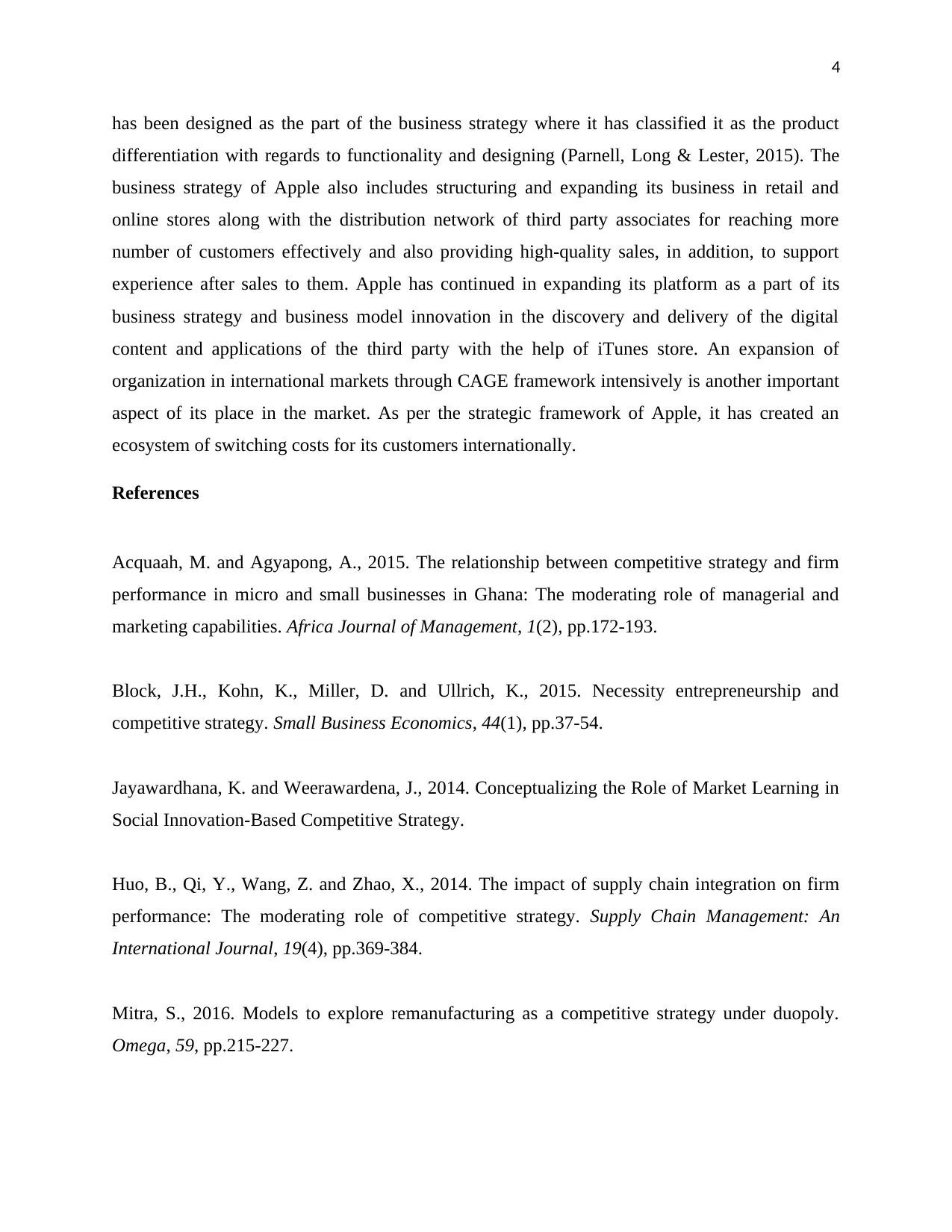
4
has been designed as the part of the business strategy where it has classified it as the product
differentiation with regards to functionality and designing (Parnell, Long & Lester, 2015). The
business strategy of Apple also includes structuring and expanding its business in retail and
online stores along with the distribution network of third party associates for reaching more
number of customers effectively and also providing high-quality sales, in addition, to support
experience after sales to them. Apple has continued in expanding its platform as a part of its
business strategy and business model innovation in the discovery and delivery of the digital
content and applications of the third party with the help of iTunes store. An expansion of
organization in international markets through CAGE framework intensively is another important
aspect of its place in the market. As per the strategic framework of Apple, it has created an
ecosystem of switching costs for its customers internationally.
References
Acquaah, M. and Agyapong, A., 2015. The relationship between competitive strategy and firm
performance in micro and small businesses in Ghana: The moderating role of managerial and
marketing capabilities. Africa Journal of Management, 1(2), pp.172-193.
Block, J.H., Kohn, K., Miller, D. and Ullrich, K., 2015. Necessity entrepreneurship and
competitive strategy. Small Business Economics, 44(1), pp.37-54.
Jayawardhana, K. and Weerawardena, J., 2014. Conceptualizing the Role of Market Learning in
Social Innovation-Based Competitive Strategy.
Huo, B., Qi, Y., Wang, Z. and Zhao, X., 2014. The impact of supply chain integration on firm
performance: The moderating role of competitive strategy. Supply Chain Management: An
International Journal, 19(4), pp.369-384.
Mitra, S., 2016. Models to explore remanufacturing as a competitive strategy under duopoly.
Omega, 59, pp.215-227.
has been designed as the part of the business strategy where it has classified it as the product
differentiation with regards to functionality and designing (Parnell, Long & Lester, 2015). The
business strategy of Apple also includes structuring and expanding its business in retail and
online stores along with the distribution network of third party associates for reaching more
number of customers effectively and also providing high-quality sales, in addition, to support
experience after sales to them. Apple has continued in expanding its platform as a part of its
business strategy and business model innovation in the discovery and delivery of the digital
content and applications of the third party with the help of iTunes store. An expansion of
organization in international markets through CAGE framework intensively is another important
aspect of its place in the market. As per the strategic framework of Apple, it has created an
ecosystem of switching costs for its customers internationally.
References
Acquaah, M. and Agyapong, A., 2015. The relationship between competitive strategy and firm
performance in micro and small businesses in Ghana: The moderating role of managerial and
marketing capabilities. Africa Journal of Management, 1(2), pp.172-193.
Block, J.H., Kohn, K., Miller, D. and Ullrich, K., 2015. Necessity entrepreneurship and
competitive strategy. Small Business Economics, 44(1), pp.37-54.
Jayawardhana, K. and Weerawardena, J., 2014. Conceptualizing the Role of Market Learning in
Social Innovation-Based Competitive Strategy.
Huo, B., Qi, Y., Wang, Z. and Zhao, X., 2014. The impact of supply chain integration on firm
performance: The moderating role of competitive strategy. Supply Chain Management: An
International Journal, 19(4), pp.369-384.
Mitra, S., 2016. Models to explore remanufacturing as a competitive strategy under duopoly.
Omega, 59, pp.215-227.
Paraphrase This Document
Need a fresh take? Get an instant paraphrase of this document with our AI Paraphraser
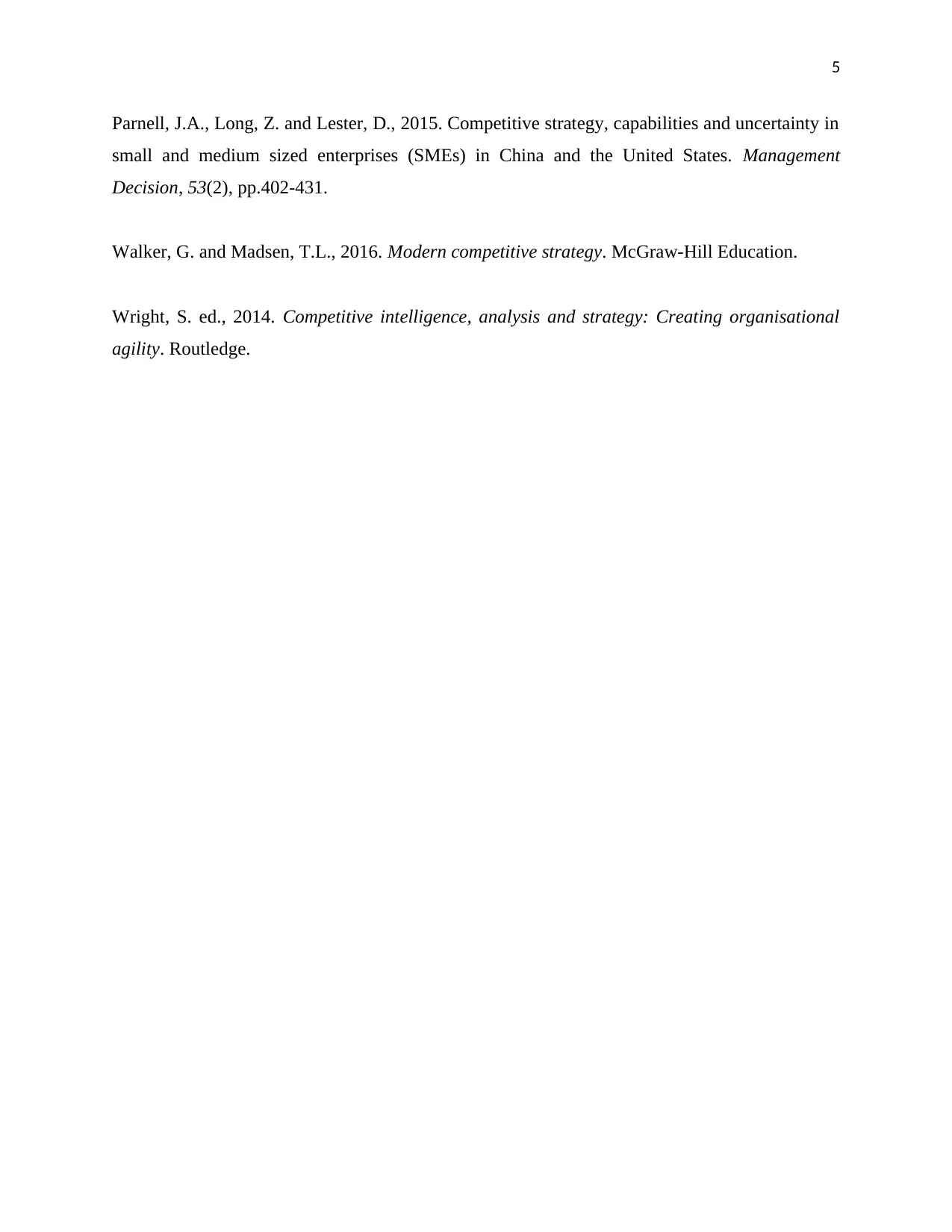
5
Parnell, J.A., Long, Z. and Lester, D., 2015. Competitive strategy, capabilities and uncertainty in
small and medium sized enterprises (SMEs) in China and the United States. Management
Decision, 53(2), pp.402-431.
Walker, G. and Madsen, T.L., 2016. Modern competitive strategy. McGraw-Hill Education.
Wright, S. ed., 2014. Competitive intelligence, analysis and strategy: Creating organisational
agility. Routledge.
Parnell, J.A., Long, Z. and Lester, D., 2015. Competitive strategy, capabilities and uncertainty in
small and medium sized enterprises (SMEs) in China and the United States. Management
Decision, 53(2), pp.402-431.
Walker, G. and Madsen, T.L., 2016. Modern competitive strategy. McGraw-Hill Education.
Wright, S. ed., 2014. Competitive intelligence, analysis and strategy: Creating organisational
agility. Routledge.
1 out of 5
Related Documents
Your All-in-One AI-Powered Toolkit for Academic Success.
+13062052269
info@desklib.com
Available 24*7 on WhatsApp / Email
![[object Object]](/_next/static/media/star-bottom.7253800d.svg)
Unlock your academic potential
Copyright © 2020–2025 A2Z Services. All Rights Reserved. Developed and managed by ZUCOL.




